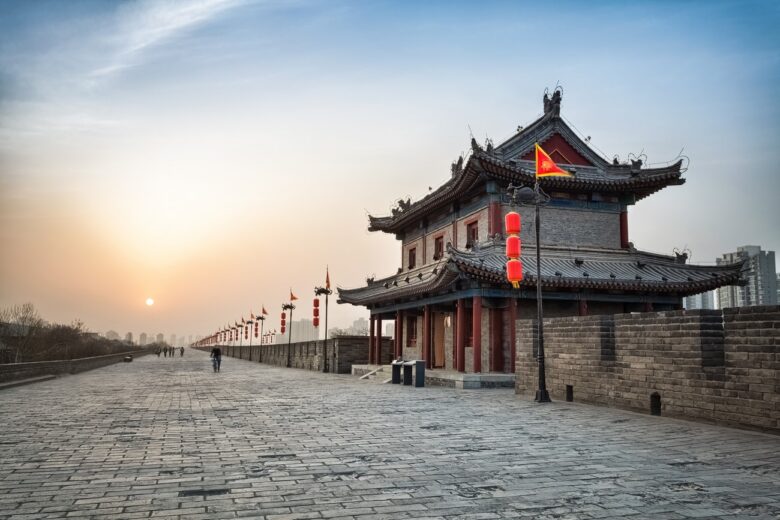
Xi’an is located in northwestern China and has a rich history spanning over 3,000 years. There are a lot of things to see in Xian, but let’s talk a little bit about it first. Before it became the capital of Shaanxi Province, it was once China’s ancient capital.
Historically, Xi’an was known as Chang’an and served as the home to the ruling house of a total of 13 dynasties. These dynasties include the Qin from 221 BC to 207 BC, the Han from 206 BC to 220 AD, and the Tang from 618 AD to 908 AD.
Xi’an has numerous historical relics, including those from the first feudal dynasty that took place in the city.
The Terracotta Army is certainly one of the first things you must see in Xian. Discovered in 1974, it is a collection of life-sized clay soldiers and horses, making it among the extraordinary archeological wonders of the world.
The city also has a significant connection to the Silk Road, a network of ancient trade routes where cultural and economic exchanges occurred between the East and West. Xi’an was the starting point of the Silk Road, thanks to its strategic location.
If you plan to visit Xi’an, you are certainly in for a treat. The city has several sights and sounds to offer. It has unique local dishes and activities to enjoy even when the sun goes down.
Without further ado, let us uncover the best things to see and do in Xian:
15 Best Things to Do in Xi’an
1. Visit The Terracotta Warriors and Horses

Also called the Terracotta Army, the Terracotta Warriors and Horses site is near the city, precisely 25 miles northeast of Xi’an in the Lintong District. It is a vast collection of clay statues representing the army of Qin Shi Huang, who was the first Emperor of China.
The Emperor believed that he needed an army to defend him as he continued his rule in the afterlife. It was his decree before he died in 210 BC.
Local farmers discovered the sculptures of soldiers, horses, and chariots in 1974 while digging a well. The Terracotta Army’s discovery was considered one of the most significant archeological finds of the 20th century.
The life-sized statues are indeed an archeological marvel, especially considering they were created more than 2,000 years ago.
A notable fact is that the sculptures have distinctive features, with various features, armor, and hairstyles. These details are believed to have been based on the actual soldiers from the Qin dynasty.
It has now become a UNESCO World Heritage site and draws in a lot of tourists from all over the world.
2. The Shaanxi History Museum
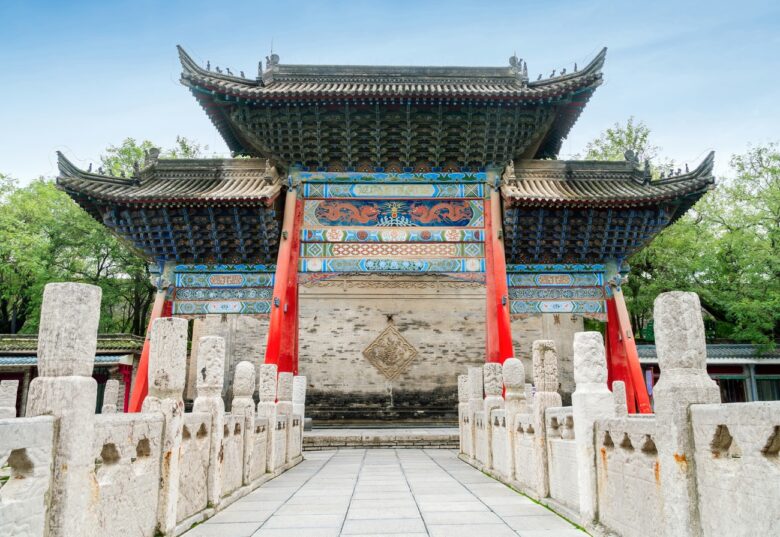
Another activity that you should absolutely do in Xian is to drop by the Shaanxi History Museum. The museum is highly regarded in the city, earning the nickname “The Pearl of Ancient Dynasties and House of Chinese Treasures.”
If you’re interested in Chinese history, this museum is a must visit, particularly because it is also part of the history itself as the first modern museum in China.
You can find the Shaanxi History Museum on Xiaozhai East Road, just on the northwest side of the Giant Wild Goose Pagoda. The museum was constructed in 1983 but did not open until 1991.
It covers a total of 16 acres (equivalent to 65,000 square meters). Of these, about 2.7 acres (11,000 square meters) contain the exhibition halls. Two more acres belong to the warehouses where you will find relics.
The museum houses an impressive collection of 370,000 exhibits that display the wealth of Chinese history. Some relics are believed to have come from prehistoric times or about 1,150,000 years ago to 1840 AD.
You can take the bus or metro to get to the Shaanxi History Museum. Note that the Metro Line 3 to Dayanta Station requires you to walk along the East Xiaozhai Road, which is about 800 meters.
You can visit the museum for free, but you will first have to make a reservation. 16000 tickets are available daily from 10 to 11 am and 6 to 7 pm.
3. See the Small Wild Goose Pagoda
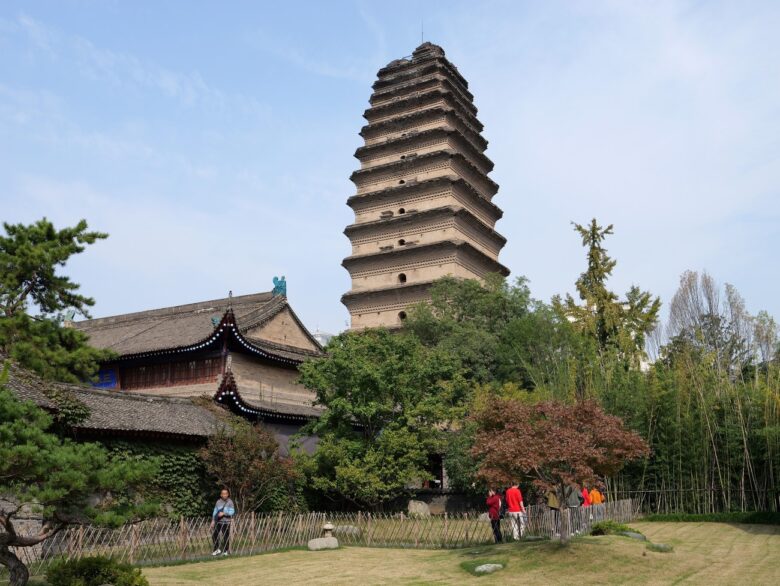
If you love historic locations, the Small Wild Goose Pagoda is certainly one of the places to see in Xian.
Originally built in 707 AD, it has existed since the Tang Dynasty with the purpose of storing and protecting Buddhist monk’s scriptures and artifacts from India. It is still well-preserved to this day after it endured earthquake damage. Some locals call it the Jianfu Temple Pagoda.
While here, you may also want to visit the Small Wild Goose Pagoda Scenic Area, where you can find gardens, ancient structures, and sculptures.
You will need to climb the Small Wild Goose pagoda to enjoy panoramic views of the area. Don’t worry; the ascent is relatively easy, although you will have to brave through a narrow staircase.
4. Drop by at the Big Wild Goose Pagoda

Another iconic site to see in Xian is the Big Wild Goose Pagoda. This famous landmark is once again associated with the Tang Dynasty and was built in 652 AD.
The initial purpose of this pagoda was similar to the Small Wild Goose Pagoda, which was to house the scriptures from a monk called Xuanzang. He collected those artifacts during his travels to India.
The pagoda standing today is different from how it was originally built, as it underwent numerous renovations and expansions over the years. Today, it has seven stories as a result of rebuilding performed during the Ming Dynasty.
Like the Small Wild Goose Pagoda, the Big Wild Goose Pagoda gives you access to the Daci’en Temple. It has been developed into a scenic park featuring lush gardens and beautiful fountains.
This pagoda is part of the Silk Roads, a UNESCO World Heritage Site, and is therefore recognized for its historical significance.
5. Visit the Giant Wild Goose Pagoda Square

Visiting the Giant Wild Goose Pagoda Square is an absolute must. You may hear some people call it Dayanta Square. Whichever you prefer, the square is indeed a “giant” or large and includes the Giant Wild Goose Pagoda and the Daci’en Temple.
This square is a central gathering place with an expansive open area to accommodate different activities you can also do in Xian. It attracts a ton of tourists daily, so beware of the large crowd, specifically during weekends and afternoons.
People visit the area to explore nearby attractions, buy souvenirs, and take photos.
If you love historical and cultural locations, you should definitely drop by the square during your visit. Getting here is easy as the Giant Wild Goose Pagoda Square is well-connected to various means of transportation.
In fact, it is a central point for people looking forward to exploring the larger Xi’an area.
6. Explore the Ancient City Wall
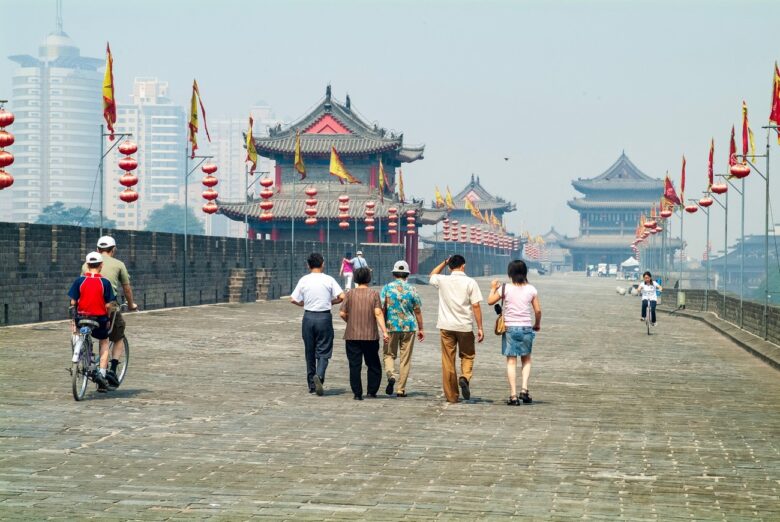
Another thing to do in Xian is to visit the Ancient City Wall. What’s so special about this wall, you ask? It is one of the most well-preserved walls in the entire country, making it a significant architectural and historical landmark.
The Ancient City Wall (or just the City Wall) was constructed in 1370 during the Ming Dynasty. The primary purpose of this wall was to protect Xi’an from invasions, serving as a military fortification against attacks.
The City Wall was effective in this regard, providing protection to the imperial capital as it enveloped the entire city. It was once surrounded by a moat, which gave it an added layer of defense.
Unfortunately, the original moat was destroyed but is now partially restored, which enhances its scenic beauty.
The wall is about 8.5 miles long, making it one of the longest walls in China. It is also quite tall, standing proudly at 39 feet. The width, however, varies, although it is wide enough for people to walk and cycle.
It has a total of four main gates, which are equipped with battlements and watchtowers to give defenders vantage points.
The Ancient City Wall is not just something to see in Xian but also experience. You can engage in various activities, including cycling, walking, and exploring the cityscape. Bikes can be rented if you wish to cycle along the wall.
Visiting the walls at night is also a nice experience, as the wall is completely and beautifully illuminated, making it safe to take evening strolls along the top.
7. Eat Some Local Food
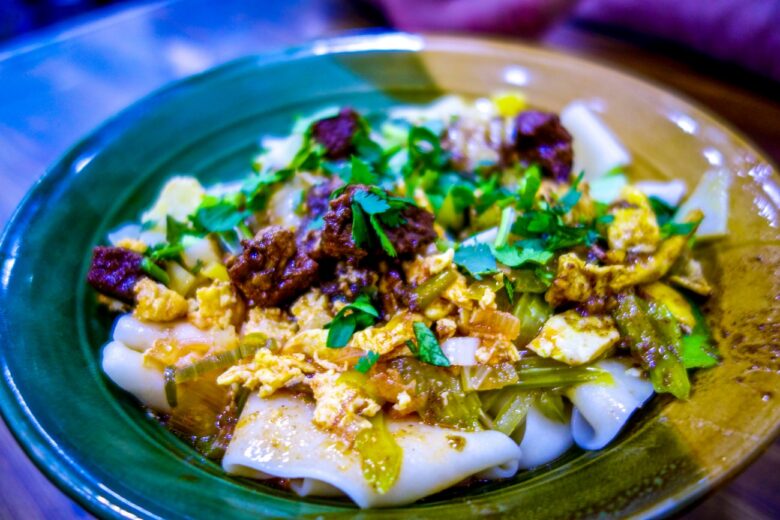
You do not have to be a foodie to add this activity to your list. Tasting local food is a must do in Xian. Aside from historical places and events, the city is known for its rich culinary heritage.
While out in restaurants, order one or more of the following:
Biangbiang Noodles (Biang Biang Mian):
Also known as yóu pō chě miàn, these noodles are hand-pulled and generally served with a spicy sauce covered in chili oil. The name “biang biang” comes from the sound made when the noodle dough is slapped against the table.
If there is one noodle dish you need to try, this one is the ultimate choice.
Biang biang is so flavorful with its strong star anise and cinnamon flavor that many people who move to the city eat it almost every day. The noodle is topped with carrots, cilantro, celery, and beans with big chunks of beef.
You can find noodle shops all over the city serving biang biang noodles, particularly in the Huimin Jie area.
Roujiamo:
The “Chinese hamburger” popularly known as roujiamo is a pork sandwich. Arguably the best street snack in the city, you have two roujiamo versions.
Try the Hui-made halal style made with beef; the other is the Han Chinese style made with pork. This sandwich is packed with so much flavor, with the perfect mix of lean and fatty meat placed inside a crispy hot pita. Some shops let you in to watch in the kitchen as they chop and scoop the meat before serving it into a steaming hot bun.
Yangrou Paomo:
This traditional dish involves breaking flatbread into small pieces before adding those pieces to a lamb-based soup.
There are actually two ways to enjoy paomo. First, you can have fresh pita bread broken into an empty bowl. Then, hand the bowl to the chef to add to the wok to cook. The other way is to have the bread broken up for you.
First-timers should certainly have the experience of breaking up the bread themselves to get a true feel for the pita. Locals recommend that you break it into very tiny pieces. That way, those small pieces soak in the flavor of the lamb stock.
Liangpi (Literally means cold skin):
These noodles are wide and cold, made from either rice or rice starch. The dish, also called spicy cold skin noodles, comes with bean sprouts, cilantro, and cucumber in a savory sauce.
Unlike many noodles, liangpi is made for the hot summer weather. It is also quite spicy yet refreshing. The noodles are served all year round in Xi’an and across China, but this dish originated from Xi’an.
Liangpi is not to be confused with another version of cold noodles in Shaanxi, which are seasoned with vinegar, soy sauce, garlic, and chili oil.
Guantang Baozi:
Also called “soup dumplings,” guantang baozi are steamed buns filled with yummy broth and meat. If it is your first time to eat the dumplings, be sure not to bite into them right away; otherwise, you will get scalded.
There are different variations of the dish where some would use beef in the baozi while others use mutton. The meat is often light, and it can melt in your mouth. Once again, be careful, or it will melt the top tissue layer of your mouth as well.
The wrappers are generally wonderfully made with a little pull, unlike glutinized dough, which is often overdone.
Jianbing:
For breakfast, try the jianbing, a savory crepe made from grain and wheat flour. Its crispy fried dough is folded into an envelope. Inside the crepe are ingredients like eggs, scallions, and coriander.
You can eat jianbing on the go, which is why it is quite popular for people who travel for work or school. This humble food has gained popularity, not only in Xi’an but also nationwide, mainly for its freshness as it is made in front of the buyers.
Additionally, jianbing is cheap yet has a multilayered flavor and texture.
Stuffed Pancakes:
Among the famous street foods in the city, the city’s stuffed pancakes are certainly a must-try if you are looking for things to eat and do in Xian. They are crispy, layered, and rolled with cabbage and spiced pork when you bite into the middle.
Like jianbing, you can watch street food vendors put the snacks together right in front of your eyes. They make the process look so simple, but in reality, the stuffed pancakes are quite complicated to make.
Qishan Noodles:
These noodles are originally from Qishan, a county close to the city of Xi’an. The dish is savory and spicy, particularly the sauce, and comes with minced beef, mutton, or pork.
One of the most exciting details about the Qishan noodle soup is that it perhaps has the most ingredients you can imagine. Included are fried meat, chives, ginger, potato, tomato, and egg.
Cumin Lamb:
These skewers are cumin-spiced lamb offered as a street food item with a delicious taste and aroma. The dish has celery, cabbage, and cilantro and is often added to biang biang noodles. The combination gives you spicy chili oils, cumin, and protein all in one.
The lamb on its own is crispy and juicy, coated with cumin and chili mix. It is then stir-fried with cilantro, garlic, and onion. Cumin lamb is quite notable in Xi’an, as well as in other bigger areas like Beijing and Shanghai. You can see it anywhere from a small diner to a high school cafeteria.
Persimmon Pastry:
Now, let us have some dessert. These persimmon pastries are a must eat in Xi’an, especially for those wanting to indulge in sweets. Each bite gives you sweetened persimmon paste.
Also known as shi zi bing, the cakes are deep-fried and usually served as street food. The dough is simple, just made from flour and fruit. The taste is so sweet with the richness of red bean and black sesame pastes.
Sometimes, you will find the pastries with ground walnuts. Needless to say, these desserts are highly addictive.
There are so many more foods to try in Xi’an. While exploring the city, you may want to avoid Huimin Jie, especially if you do not want the trouble of dealing with a jam packed tourist area. Instead, try the streets of Sajinqiao, Maiohoujie, and Dapiyuan.
8. Discover the Muslim Quarter

Above, we explicitly mentioned avoiding Huimin Jie. However, the Muslim Quarter, or Huimin Jie, is certainly a must see in Xian. This statement is true if you do not mind the busy area filled with tourists and locals, as it is where people eat a variety of flavorful snacks.
This reason alone is why Huimin Jie is called “A Street for Gourmet.” Located at the heart of Xi’an, Huimin Jie is just right next to the Drum Tower. It is considered the center of the Muslim Community in the city, spanning about 500 meters from north to south.
This area has quite an interesting history that began about 1,000 years ago. During the Han Dynasty, Huimin Jie was seen as the opening point of The Silk Road.
Originally, the street was filled with Persians and Arabs, along with diplomatic envoys from other parts of the world and overseas students. Eventually, the population increased as the residents moved, married, and had children.
Today, it has about 60,000 Muslims residing here, many of them with ties to the old immigrants.
The Muslim Quarter offers plenty of things to do and see in Xian, including:
- The God Temple
- The Ming Dynasty’s Xicheng Gateway
- Tang Dynasty’s Hanguang Gate
- Gao Family Compound (for puppet shows and shadow plays)
The Muslim Quarter is also full of shopping stores and restaurants, showcasing architectural styles of the Ming and Qing Dynasties.
While here, you may want to try the halal versions of the popular Xi’an dishes, such as roujiamo or the Chinese hamburger and mutton or beef and pita bread in soup (yangrou paomo).
As previously discussed, Huimin Jie is incredibly busy, particularly during weekends and holidays. You could get lucky if you arrive early in the morning and midday. However, if you are not a fan of crowds, you may want to go somewhere else in the evenings for dinner.
The district is open 24/7, so you have plenty of time to explore the area.
There are bargain shops everywhere. If you are looking into buying some souvenirs, select the shops located inside small alleys for cheaper prices.
9. Learn More about the Bell and Drum Towers
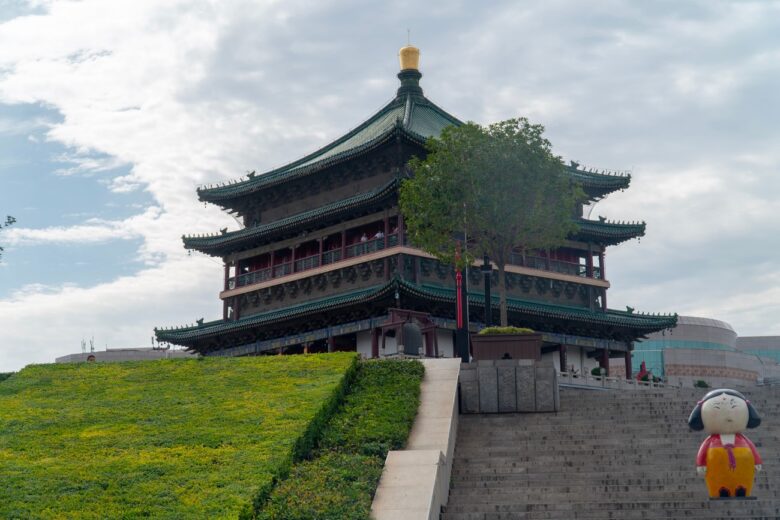
All Chinese cities that were in existence during the Ming dynasty had bell and drum towers. These towers were used to tell the residents the time of the day. In some cases, they are for marking important events.
Xi’an’s Bell and Drum towers originated at the very beginning of the Ming Dynasty back in the 1380s. The towers signify the city’s noteworthy history, which is why they are some of the best-preserved landmarks in China.
The Bell Tower is in a busy traffic circle at Xi’an’s very center, standing tall and proud at 90 feet (27.4 m). In order for visitors like you to reach the tower, you will first have to take an underground walkway, which is located underneath the traffic circle.
When you reach the tower, don’t forget to climb up to the terrace, which will test your resilience as it requires climbing many stairs. Unfortunately, many people agree that the view is not that impressive. After all, you will just see busy roads in all directions.
Inside the tower, however, you will see a small bell, along with handwritten memos about the renovation and relocation of the tower, in a small museum. Be sure to ask if there are any bell and chime performances on your visit if you are interested in such shows.
Now, onto the Drum Tower, which is situated at the south end of Beiyuanmen. The tower is about 200 meters from the Bell Tower to the northwest. This iconic landmark was built in 1380 and is believed to be older than the Bell Tower.
The Drum Tower, as its name suggests, holds large drums. It also contains antique furniture, and you can watch musical performances that showcase drums and traditional instruments.
I recommend you go to a square between the two towers for good views. The square is also a great area for strolling, with lots of trees and benches for sitting. It’s always a good idea to visit the square, even at noon.
Take note that the towers can only be visited from 8:30 am to 10 pm from April to October. If you’re in Xi’an from November to March, you can see the towers only until 6 pm. Entrance is not free.
You can visit both the Drum Tower and Bell Tower by purchasing a combo ticket. A combo ticket is worth 50 CNY
10. Enjoy the Tang Dynasty Music and Dance Show

The Tang Dynasty Show, or the Music and Dance Dinner Show in Xian, is hosted at the Tang Dynasty Palace.
It is the pride and joy of the city, which is why it is held at one of the leading entertainment theaters in China. While here, you can also enjoy other Cantonese delicacies.
The show is filled with excellent performances that fully display the Tang Dynasty’s music and dance art, which existed from 618 to 907. It is considered the premier pseudo-classic show in the whole country, which is why it is certainly a must see in Xi’an.
The Tang Dynasty Show has a total of eight sections:
- Hooray to the Emperor, which depicts the scenes of the Emperor holding court with his important officials
- White Linen Dance, a creation of the Jin Dynasty (256 to 316) where all the dancers wear white linen skirts and long sleeves
- Da Nuo, a type of sacrifice dance with simple movements and religious expressions with the purpose of praying for good luck and warding off evil spirits
- Rainbow and Feather Garment Dance, created by the Tang Dynasty’s Emperor Xuanzong (658 to 762) who dreamed about girls dancing to soft music in the Moon Palace
- The Prince of Qin Breaking Through the Battle Line Dance, a military dance that displays the Tang Dynasty’s military prestige
- Spring Outing, a scene depicting high ranking officials and scholars enjoying outdoors in the early spring with music played by a pipa, ruan, and guzheng
- Orioles Twittering in Spring, the only piece played by panpipes in the country, featuring a lively melody to symbolize the Tang Empire’s prosperity
- The Feet Stomping Song, performed with stomping feet for rhythm, involves a kaleidoscope with performers singing and dancing while holding hands
As you appreciate the music and dancing, you also have the chance to taste Tang Dynasty Palace’s delicious dishes and wine.
The Palace banquet can hold up to 650 guests who have choices ranging from authentic Tang dishes served to royalty to traditional Cantonese dishes.
11. Learn More about History in the Huaqing Hot Springs – Huaqing Palace

Why not head to the Huaqing Chi Hot Springs for a relaxing day? It is situated at Lishan Mountain, which is about 25 km east of Xi’an, in the Lintong District. You can access the hot springs from 7:30 am to 6 pm.
The best time to visit is definitely in spring, from March to May. However, if that is not a choice, you can pick the autumn season, which is from September to November.
Huaqing Hot Springs is also known as Huaqing Palace and is considered a historic site. It is a 5 A tourist attraction, meaning it contains everything you need: Accommodation, Accessibility, Activities, Amenities, and Attractions.
The palace is best known for the romantic story of Tangxuanzong, an Emperor of the Tang Dynasty (618 to 907), and Yang Guifei, his beloved concubine.
Aside from that, the palace was also the favorite place for short stays of emperors seeking to be away from the capital. Emperors of various dynasties, including Tang, Sui, Han, and Qing, spent their winter at the hot springs.
It is believed that Emperor Zhouyouwang of the Western Zhou Dynasty (1046 BC to 771 BC) ordered the palace built. The subsequent dynasties then repaired and expanded it, naming it the Hot Spring Palace. It was Emperor Tangxuanzong who gave it the name Huaqing Palace.
The site is called Huaqing Hot Springs because the palace was built above a hot spring. But there are more reasons to visit the area, including the Lotus Garden, which spans about 30,000 square meters.
It comprises the Changsheng Palace or the Palace of Eternal Life, along with other popular wings like the Guolao Medicine House, Debao Building, and Lotus Lake.
While here, you may not want to miss the relic of the Imperial Hot Spring, which was discovered in April 1982. Excavation for this relic lasted more than three years.
The activity led to the unearthing of five imperial hot spring sites, such as the Begonia Spring and the Star Spring. Additionally, over 3,000 pieces of ancient articles were also discovered.
12. Head to the Forest of Stone Steles Museum

Called Bei Lin, the Stele Forest Museum is located at 15 Sanxue Street, which is easily recognizable when you see the City Wall’s south gate. The museum was established in 1090 during the reign of the Northern Song Dynasty (from 960 to 1279).
It is quite known all over the city for its fine collection of over 1,000 engraved stones originating from the Han Dynasty (206 BC to 220 AD) to the Qing Dynasty (1644 to 1911).
The Forest of Stele Museum or the Forest of Stone Steles Museum is one of the best places to visit if you wish to get close to Chinese culture and history.
It is expansive, covering 31,000 square meters with seven exhibition halls. These halls mainly display calligraphy works, stone carvings, and historical records:
- Exhibition Hall One displays the text of 12 Confucian classics, including the Books of Changes, Analects of Confucius, and the Books of Songs, which were engraved on 14 steles.
- Exhibition Hall Two has calligraphy steles created by the prominent ancient Tang Dynasty calligraphers, including Zhang Xu and Yan Zhenqing. It was at this time when Chinese classic calligraphy was at its peak.
- Exhibition Hall Three also has calligraphy works inscribed with seal characters, regular and official script, cursive hand, and running. The displays show the differences in Chinese writing as time passed.
- Exhibition Hall Four contains different stone sculptures, including about 200 works from the Han Dynasty and Tang Dynasty. You will also find portraits of important figures, such as Confucius, along with Buddhist scriptures.
- Exhibition Halls Five, Six, and Seven showcase engraved historical records from different dynasties up to the last imperial age of China. Poems are displayed in the last two halls.
You can also find two sculpture galleries in the museum besides the seven exhibition rooms. The east gallery is new and focuses more on the development of Buddhism in Xi’an. The other hall has about 70 exhibits from the Han and Tang Dynasties. You can find the older gallery on the west.
13. Learn the Art of Chinese Writing with Calligraphy Classes

Chinese calligraphy is an integral part of Chinese culture. It is more than a way to communicate, as it does have an element of artistry.
It sure is a unique way to spend your time while in Xi’an. Amateur enthusiasts and professional artisans practice Chinese calligraphy for a variety of reasons, including recording Chinese information and creating forms.
When you join a calligraphy class, you will need brushes to ink different script styles, namely seal, cursive, regular, running, and official. Each stroke is believed to be a stroke of personal growth as you intertwine it with skill development.
At the end of the class, you will gain an understanding of the profound aesthetic in this art form that has existed since ancient times.
Most classes include displaying and learning more about the calligraphy works of local calligraphers. You will also get basic knowledge of the materials used in calligraphy, like writing brush, paper, ink, and ink stone.
You can find a 1:1 calligraphy class, which will help you learn quickly and more confidently.
And while you are at it, challenge yourself with the word “biang” from the Biangbiang noodles we discussed above. The Chinese character is one of the most complex there is in contemporary usage, containing a total of 58 strokes!
14. Take Some Chinese Cooking Classes

There is art involved in cooking many Chinese dishes. You’re probably mistaken if you think you know how to cook them by following a recipe online. Chances are your very own version of the sweet and sour Chinese foods you have frequently tried at a Chinese restaurant is a flimsy version of the authentic dishes.
You can find authentic Chinese cooking classes in Xi’an. It is one of the most productive things you can do in the city. You will learn more about Chinese cuisine with other amateur home cooks and even student and professional chefs.
Most quick courses include a brief history of Chinese cooking, as well as cooking methods like stir-frying, roasting, steaming, and smoking. You will also learn about noodles and rice, along with traditional flavors that are well-known all over Xi’an and other cities in China.
Most classes also provide learning about conventional kitchen equipment, such as wok and knives.
15. See and Experience the Tang Paradise

Tang Paradise is considered the most extensive Tang-style imperial garden, not just in Xi’an but the entire country of China. You can find it in the Qujiang Resort southeast of Xi’an City, just near the Giant Wild Goose Pagoda.
The garden covers 165 acres, 49 acres of which are made up of water. Tang Paradise is said to be the largest cultural theme park in northwest China. It also gained fame because it is the first to showcase the Tang Dynasty culture in the form of a garden-like park.
Tang Paradise offers 12 scenic regions, meaning visitors get to see and experience 12 cultural themes. This park perfectly displays the prosperity and magnificence of the Tang Dynasty culture.
It is undoubtedly one of a kind, with its designers integrating everything that prominently represents the Tang Dynasty. The garden has food, marketplaces, dance and songs, poetry, and women’s lifestyles on every site. Thus, a story is embedded within each of the 12 regions.
The best thing about the park is that you can visit it all year round without worrying about the weather. However, Irecommend that you drop by in spring and summer.
Visiting times vary, but you can see the sights and sounds within one to three hours. Tang Paradise is open from 9 am to 10 pm. Tickets are sold per person for 120 CNY.
There you have it! Fifteen exciting things to do and see in Xian. The beautiful city is indeed full of historic relics, from the Terracotta Army to the City Wall to the Giant Wild Goose Pagoda.
The great thing about being in the area is that, apart from the Terracotta Army, most attractions are just about 25 miles (40 km) northeast of downtown. You can also reach almost all interesting and popular sites by metro.